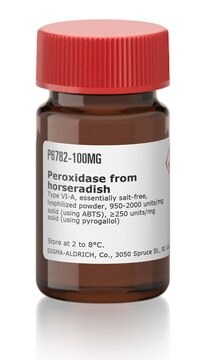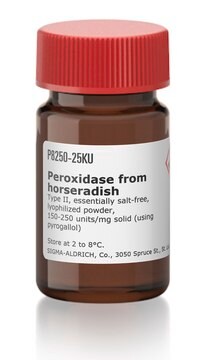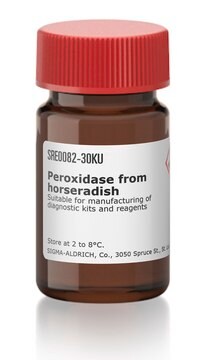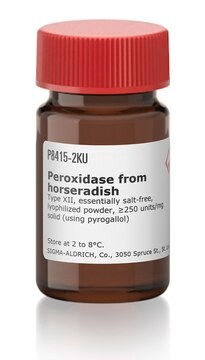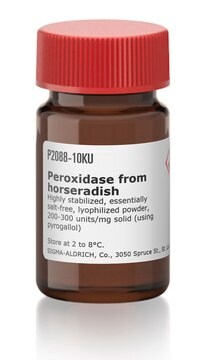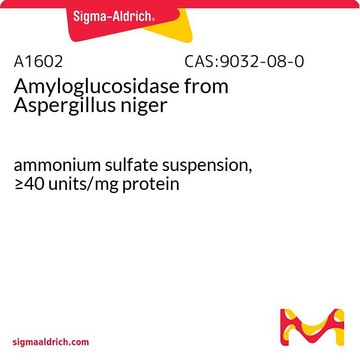P8125
Peroxidase from horseradish
Type I, essentially salt-free, lyophilized powder, ≥50 units/mg solid (using pyrogallol)
Synonym(s):
Donor:hydrogen-peroxide oxidoreductase, Horseradish peroxidase
Sign Into View Organizational & Contract Pricing
All Photos(3)
About This Item
Recommended Products
type
Type I
Quality Level
form
essentially salt-free, lyophilized powder
specific activity
≥50 units/mg solid (using pyrogallol)
mol wt
~44 kDa
solubility
0.1 M phosphate buffer: soluble (pH 6.0)
H2O: soluble
absorbance ratio
RZ ≥1.0
storage temp.
2-8°C
InChI
1S/H2O3/c1-3-2/h1-2H
InChI key
JSPLKZUTYZBBKA-UHFFFAOYSA-N
Looking for similar products? Visit Product Comparison Guide
General description
Horseradish peroxidase is isolated from horseradish roots (Amoracia rusticana) and belongs to the ferroprotoporphyrin group of peroxidases. HRP is a single chain polypeptide containing four disulfide bridges. It is a glycoprotein containing 18% carbohydrate. The carbohydrate composition consists of galactose, arabinose, xylose, fucose, mannose, mannosamine, and galactosamine depending upon the specific isozyme. Its molecular weight (~44 kDa) includes the polypeptide chain (33,890 Daltons), hemin plus Ca2+ (~700 Daltons), and carbohydrate (~9,400 Daltons). At least seven isozymes of HRP exist. The isoelectric point for horseradish peroxidase isozymes ranges from 3.0 - 9.0.
Application
Peroxidase from horseradish has been used:
- in fecal starch analysis
- to measure plasma glucose levels by Trinder method
- to incubate feruloylated arabinoxylan fractions and also to evaluate oxidative coupling
- in the detection of glycoproteins
Biochem/physiol Actions
HRP readily combines with hydrogen peroxide (H2O2) and the resultant [HRP-H2O2] complex can oxidize a wide variety of hydrogen donors. The optimal pH is 6.0-6.5 and the enzyme is most stable in the pH range of 5.0-9.0. HRP can be conjugated to antibodies by several different methods including glutaraldehyde, periodate oxidation, through disulfide bonds, and also via amino and thiol directed cross-linkers. It is smaller and more stable than the enzyme labels β-galactosidase and alkaline phosphatase.Hence, it is the most desired label. Also, its glycosylation leads to lower non-specific binding. It is also used for the determination of glucose and peroxides in solution. Sodium azide, cyanide, L-cystine, dichromate, ethylenethiourea, hydroxylamine, sulfide, vanadate, p-aminobenzoic acid, and Cd2+, Co2+, Cu2+, Fe3+, Mn2+, Ni2+, Pb2+ ions are known to inhibit the enzyme activity.
When incubated with a substrate, horseradish peroxidase produces a coloured, fluorimetric, or luminescent derivative of the labeled molecule, allowing quantification.
Unit Definition
One pyrogallol unit will form 1.0 mg purpurogallin from pyrogallol in 20 sec at pH 6.0 at 20 °C.
Analysis Note
The RZ (Reinheitszahl) is the absorbance ratio A403/A275 determined at 0.5-1.0 mg/ml in deionized water. It is a measure of hemin content, not enzymatic activity. Even preparations with high RZ may have low enzymatic activity.
Other Notes
View more information on peroxidase at www.sigma-aldrich.com/enzymeexplorer.
Inhibitor
Product No.
Description
Pricing
Substrate
Product No.
Description
Pricing
signalword
Danger
hcodes
pcodes
Hazard Classifications
Resp. Sens. 1
Storage Class
11 - Combustible Solids
wgk_germany
WGK 1
ppe
Eyeshields, Gloves, type N95 (US)
Choose from one of the most recent versions:
Already Own This Product?
Find documentation for the products that you have recently purchased in the Document Library.
Customers Also Viewed
Mirian M da Silva et al.
American journal of physiology. Heart and circulatory physiology, 285(1), H154-H162 (2003-03-08)
Ischemic preconditioning, or the protective effect of short ischemic episodes on a longer, potentially injurious, ischemic period, is prevented by antagonists of mitochondrial ATP-sensitive K+ channels (mitoKATP) and involves changes in mitochondrial energy metabolism and reactive oxygen release after ischemia.
Cultivar discrimination of Portuguese Lupinus albus by seed protein electrophoresis: the importance of considering glutelins and glycoproteins
Vaz A C, et al.
Field Crops Research, 87(1), 23-34 (2004)
Studies on the oxidative cross-linking of feruloylated arabinoxylans from wheat flour and wheat bran
Schooneveld-Bergmans M E F, et al.
Carbohydrate Polymers, 38(4), 309-317 (1999)
Tamara Allen et al.
Diabetes, 55(9), 2523-2533 (2006-08-29)
Halofenate has been shown previously to lower triglycerides in dyslipidemic subjects. In addition, significant decreases in fasting plasma glucose were observed but only in type 2 diabetic patients. We hypothesized that halofenate might be an insulin sensitizer, and we present
Acarbose enhances human colonic butyrate production
Weaver G A, et al.
The Journal of Nutrition, 127(5), 717-723 (1997)
Our team of scientists has experience in all areas of research including Life Science, Material Science, Chemical Synthesis, Chromatography, Analytical and many others.
Contact Technical Service

